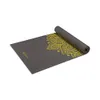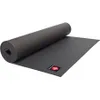Somatic exercise coach shares 3 stretches to boost your mind-body connection and release tension
Reconnect with your body with mindful, gentle movement

You may be most familiar with exercises that involve repeating the same movements over and over, like lifting the best adjustable dumbbells for multiple reps and sets to build strength and muscle, or taking stride after stride to perfect your running form and get faster.
However, amidst your usual workouts, how often do you slow down and truly connect with what your body is doing and how it feels? This is exactly what somatic exercise is all about, and it offers some impressive benefits.
Somatic practice focuses on developing full-body awareness, encompassing both physical and mental wellbeing. It involves moving your body in a way that prioritizes how it feels rather than how it looks or achieving a specific fitness goal.
This also means it is a super accessible form of movement for people to try out and probably something we could all do with incorporating into our fitness routine, similar to taking a slower, more purposeful mindful walk.
With that in mind, we spoke to a professionalsomatic movement coach Francesca Melluzzi, to understand more about somatic movement, the benefits of practicing it and how to try it out for yourself right now.

As a compassionate Hanna Somatic Movement Coach, Trauma and Mental Health Practitioner, Senior Yoga Teacher, and Holistic Therapist, Francesca brings a wealth of knowledge and empathy to her work. With over 20 years of experience, Francesca specialises in somatic techniques that help individuals find a sense of calm and improve their executive functioning.
What is somatic exercise?
According to Melluzzi, "Somatic exercise involves mindful movements aimed at re-establishing the connection between the body and mind. It focuses on internal body sensations and aims to release chronic muscle tension and pain patterns stored in the body."
She tells us that regular practice of somatic exercise can help you to retrain your brain-body connection, helping to promote relaxation and improve physical well-being.
Sign up to get the BEST of Tom's Guide direct to your inbox.
Get instant access to breaking news, the hottest reviews, great deals and helpful tips.
What are the benefits of somatic exercise?
Physical relief: "Somatic movement can help alleviate chronic muscular pain, fibromyalgia, and arthritis," says Melluzzi. These gentle movements focus on releasing tension stored within the muscles, providing a natural and effective way to alleviate discomfort.
This is backed up by a study published in Frontiers in Psychology, which found that individuals with chronic pain who consistently practiced somatic movement for a year experienced an 86 percent decrease in the number of days they suffered from pain, compared to those who did not participate in somatic exercises.
Emotional and mental health support: Beyond physical benefits, somatic exercise can play a crucial role in supporting emotional and mental health. This style of movement works to help manage anxiety, stress, and depression by regulating emotions and balancing the nervous system.

Holistic healing: Melluzzi tells us that regular practice can enhance various parts of our physiological well-being including better digestion, promote hormonal balance, and improve sleep quality.
This is down to the fact that the gentle, mindful form of movement allows your nervous system to relax, easing any tensions and disturbances that can have a negative effect in these parts of our health.
Empowerment: "These exercises empower individuals to take an active role in their healing own process," notes Melluzi. The movememt enhances internal body awareness and promotes self-regulation, encouraging a deeper connection with oneself. That might sound a bit woo-woo to you, but don't knock it until you try it.
Who should try somatic exercise?
Somatic exercise is ideal for anyone. Whether you are looking to enhance your mind-body awareness, manage stress, or simply improve your overall mindfulness and wellbeing, we recommend giving it a try.
But Melluzzi tells us it is also particularly beneficial for individuals with ADHD and autism spectrum disorders (ASD) who experience sensory processing challenges and chronic pain. It also aids people in managing conditions like fibromyalgia, arthritis, or those recovering from injuries.
How to try somatic exercise
A photo posted by on
You don't need any equipment to give somatic exercise a try with Melluzi's three-move routine, just a bit of space where won't be disturbed as you lay on the floor. If you want to make things a bit more comfortable, you can roll out a yoga mat too, before starting on these three stretches:
- Body scan: Lie on your back, sense your body's contact with the floor, and observe any areas of tension or discomfort.
- Washrag: Lie on your back with knees bent, gently rotate your upper body and drop knees to one side, then slowly release.
- Arch and flatten: Lie on your back, focus on your breath, gently arch your lower back by tilting your pelvis, hold briefly, and then release slowly.
More from Tom's Guide
- The best relaxation apps to put your mind to rest
- I took a mindful walk every day for a week — here's how it changed my mind and body
- I tried a week of gratitude runs to boost my well-being — here's 3 ways it changed my training

Jessica has been a fitness writer at Tom’s Guide since 2023, bringing three years of experience writing about health, fitness, and the great outdoors. Her passion for exercise began during her childhood, where she spent weekends hiking and competing in local athletics club events. After earning a master’s degree in journalism from Cardiff University, Jessica found the perfect way to combine her love of storytelling and fitness into a career.
Jessica is passionate about testing fitness gear and tech, using her reviews to help readers make informed buying decisions. She ran her first marathon in April 2024, finishing it in 3 hours and 48 minutes. Through her training, she’s developed a deep understanding of what it takes to grow as a runner, from effective workouts and recovery techniques to selecting the right gear for every challenge.
When she’s not at her desk, Jessica enjoys spending time in the kitchen crafting new recipes, braving cold water swims and hiking.









